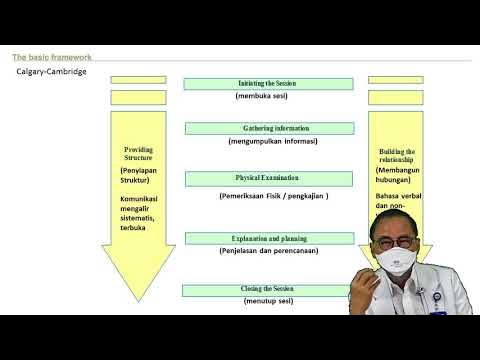Komunikasi SBAR (Situation, Background, Assessment, Recommendation)
Summary
TLDRThis video provides a practical tutorial on effective communication using the SBAR (Situation, Background, Assessment, Recommendation) method in healthcare settings. It explains how SBAR allows healthcare professionals to efficiently and clearly relay important information about a patient's condition. The video illustrates an example of SBAR communication between a nurse and a doctor regarding a patient's post-operative status, highlighting key steps such as assessing vital signs, fluid management, and treatment recommendations. This approach ensures smooth and effective communication in critical healthcare scenarios.
Takeaways
- 😀 SBAR (Situation, Background, Assessment, Recommendation) is an effective and efficient communication model used for reporting patient conditions in medical settings.
- 😀 SBAR aims to deliver up-to-date information about patient conditions and any changes that occur during treatment.
- 😀 The four components of the SBAR model are: S (Situation), B (Background), A (Assessment), and R (Recommendation).
- 😀 A video demonstration shows the practical application of SBAR communication between a doctor and a medical team at RSUD Provincial Hospital of West Nusa Tenggara.
- 😀 The patient in the demonstration is a female with endometrial cancer who has undergone a hysterectomy and is currently experiencing post-operative complications.
- 😀 The patient's vital signs are concerning, with low blood pressure (90/52 mmHg), a low GCS (Glasgow Coma Scale) score, and irregular heart rate (120 beats per minute).
- 😀 The medical team is monitoring various aspects, such as oxygen levels, urine output, bleeding, and drainage production, to assess the patient's condition.
- 😀 The doctor is requested to approve additional treatments, such as intravenous fluid loading (500cc RL) and adjustments to existing medication dosages.
- 😀 Recommendations include observing the patient's vital signs, assessing for bleeding or changes in urine output, and reporting back for further evaluation if necessary.
- 😀 The medical team ensures thorough communication by confirming all details, including medication doses, vital sign observations, and the results of laboratory tests, with the doctor.
Q & A
What is SBAR communication?
-SBAR stands for Situation, Background, Assessment, and Recommendation. It is an effective and efficient communication method used by healthcare professionals to share important patient information, particularly during shifts or changes in patient condition.
What does each component of SBAR represent?
-The SBAR communication model is divided into four components: 'S' for Situation, which describes the patient's current condition; 'B' for Background, which provides relevant medical history; 'A' for Assessment, which includes the healthcare professional's analysis of the situation; and 'R' for Recommendation, which suggests the next steps or actions required.
What is the purpose of SBAR communication?
-The purpose of SBAR communication is to ensure that healthcare providers can quickly and clearly communicate the current status of a patient, especially in critical situations, so that necessary actions can be taken effectively and without delay.
How is SBAR communication applied in the script?
-In the script, SBAR is used during a conversation between a nurse (PPA) and a doctor (DPJP). The nurse reports a patient's condition by providing information about the situation, background, assessment, and recommending additional actions, such as administering fluids and adjusting medication.
What specific patient condition is reported in the script?
-The patient is described as apatic, agitated, with a Glasgow Coma Scale (GCS) score of E4, V3, M5. The patient’s vital signs include low blood pressure, a heart rate of 120 beats per minute, and stable oxygen saturation. The nurse also mentions the patient’s cold extremities, urine output, and history of surgery.
What specific treatment and actions were mentioned for the patient?
-The nurse reports administering a fluid bolus of 500cc of Ringer's Lactate and recommends increasing the dose of tranexamic acid to manage bleeding. The nurse also suggests starting a continuous intravenous infusion of 0.05 micrograms per kilogram per hour and closely monitoring the patient's vital signs, bleeding, and urine output.
What is the significance of the Glasgow Coma Scale (GCS) mentioned in the script?
-The Glasgow Coma Scale (GCS) is used to assess a patient's level of consciousness. In the script, the patient's GCS is mentioned as E4 (eye response), V3 (verbal response), and M5 (motor response), indicating a moderately impaired state of consciousness, which helps healthcare professionals evaluate the urgency of intervention.
What is the reason behind administering tranexamic acid?
-Tranexamic acid is used to reduce bleeding. In the script, it is administered as part of the patient's post-surgical care, particularly to manage potential hemorrhaging following the procedure.
What role does the nurse play in this SBAR communication?
-The nurse plays a crucial role in gathering and presenting all relevant information about the patient's condition, providing an assessment based on their observations, and making a recommendation to the doctor for further treatment or monitoring.
What is the importance of reassessing the patient as suggested in the script?
-Reassessing the patient after the interventions ensures that the treatment plan is effective. If there is no change in the patient's condition, further adjustments or additional interventions may be necessary. Continuous monitoring of vital signs, urine output, and bleeding is critical for early detection of complications.
Outlines

This section is available to paid users only. Please upgrade to access this part.
Upgrade NowMindmap

This section is available to paid users only. Please upgrade to access this part.
Upgrade NowKeywords

This section is available to paid users only. Please upgrade to access this part.
Upgrade NowHighlights

This section is available to paid users only. Please upgrade to access this part.
Upgrade NowTranscripts

This section is available to paid users only. Please upgrade to access this part.
Upgrade NowBrowse More Related Video

SBAR (Situation | Background | Assessment | Recommendation) | ABCDE Emergency | OSCE Guide | PLAB 2

Roleplay SKP 2 - Peningkatan Komunikasi Efektif [Kelompok 2 | AJ1 | B26 | Universitas Airlangga]

Interprofessional Collaborative Communication

KOMUNIKASI SBAR

SBAR | Reality-Based Toolkit

Komkes (Pengantar) - dr. Arif Hari Martono Marsaban, SpAn-KAP
5.0 / 5 (0 votes)